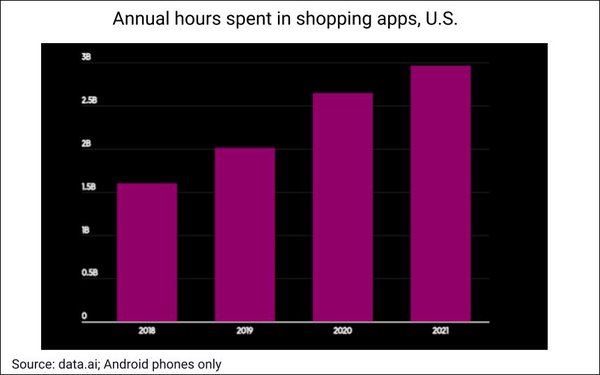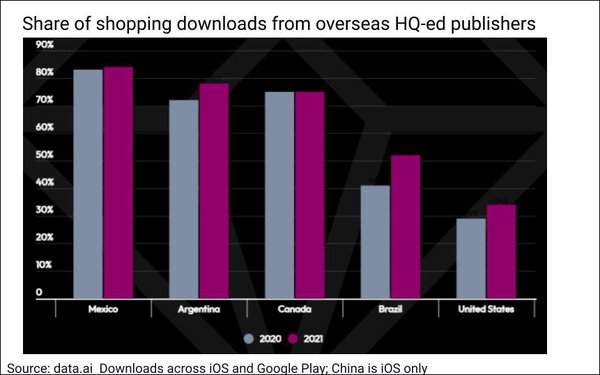Commentary
Time Spent In Shopping Apps Exceeded 100B Hours In 2021
- by Karlene Lukovitz @KLmarketdaily, April 7, 2022

How rapidly is mobile shopping accelerating?
Well, worldwide, total annual hours spent inside shopping apps—on Android phones only — increased more than 18% last year, to 100.5 billion from nearly 85 billion in 2020, according to data.ai (formerly App Annie).
That works out to an average of about 2 billion hours per week.
Meanwhile, in the U.S., annual hours in these apps rose more than 12%, from 2.65 billion in 2020 to 2.97 billion last year.
The numbers are even more impressive on a three-year timeline.
Worldwide, annual hours have more than doubled since 2018, when they logged in at 48.7 billion.
In the U.S., they’re up 54%, from 1.6 billion in 2018:

Most sectors saw growth, but the biggest jumps were seen in fast fashion, social shopping and mobile-savvy big-box players.
Looking at the top 20 shopping apps worldwide in terms of year-over-year growth in downloads, No. 1 was India’s Meesho — actually a B2B product. It powers an online marketplace that connects small and micro business owners with customers via social media channels including WhatsApp, Facebook and Instagram.
Meesho, which raised $570 million in funding at a valuation of $4.9 billion last September, is targeting 100 million users by the end of 2022.
Singapore-based Shopee was No. 2 in downloads growth but No. 1 in monthly active users worldwide. Now active in 13 countries across Asia, Latin America and Europe, Shopee $6.1 billion in gross
orders last year — up 117% year-over-year.
Just two U.S.-heaquartered apps made the top 20 by download growth: Nike, at No. 15, and PatPat, known primarily for kids’ clothing, at No. 19.

Globalization is very much the trend in shopping apps.
In Mexico, fully 84% of total shopping-app downloads are apps from companies headquartered outside of Mexico.
Other countries with notably high use of non-domestic apps include (78%), France (77%), Australia (75%) and Canada (75%).
In what can be read as good news from a brand loyalty standpoint, the U.S. lags other countries in this regard.
Although the percentage of downloads from other countries rose from 29% to 34% in the U.S. between 2020 and 2021, that means that 66% of shopping downloads are still from U.S.-based brands.

The shopping apps trends data is taken from data.ai's State of Mobile 2022 report.



